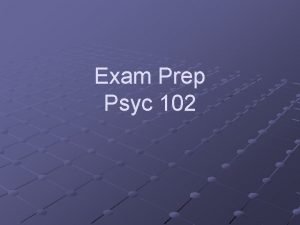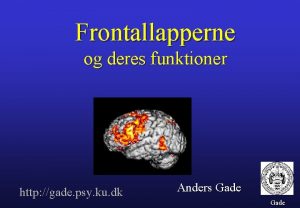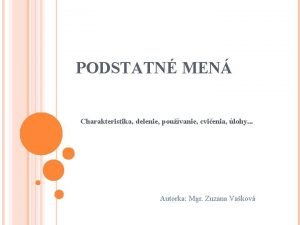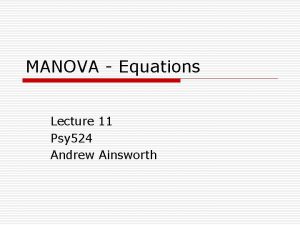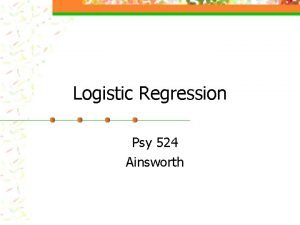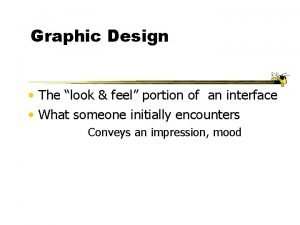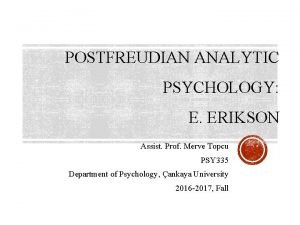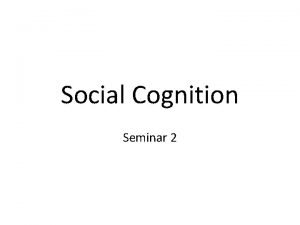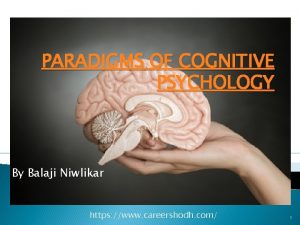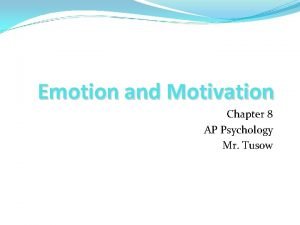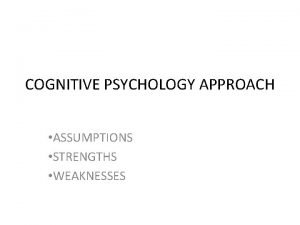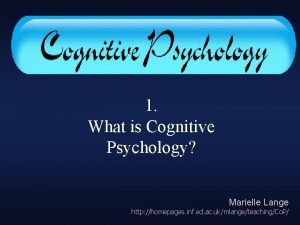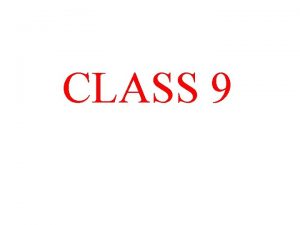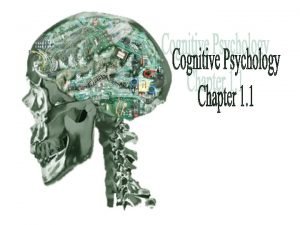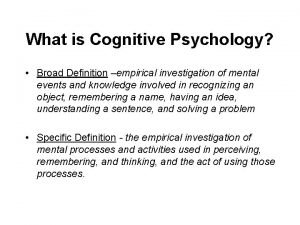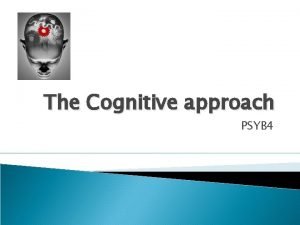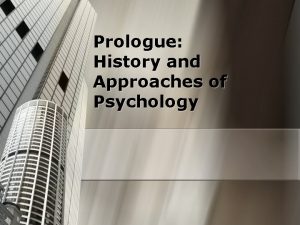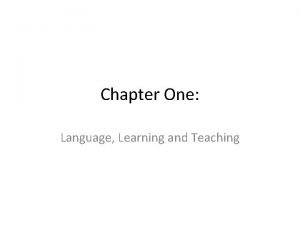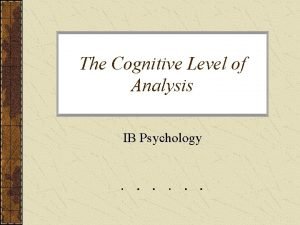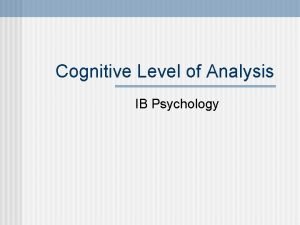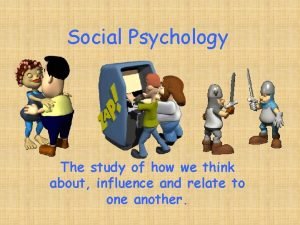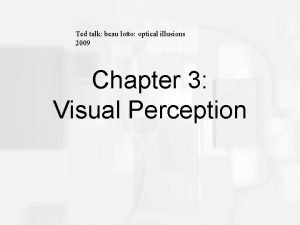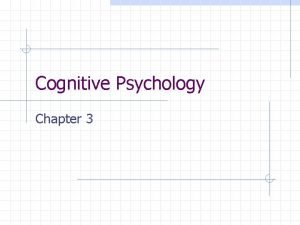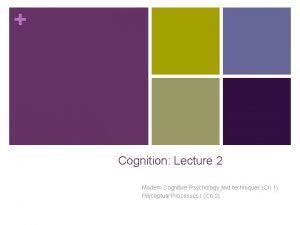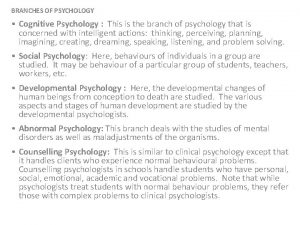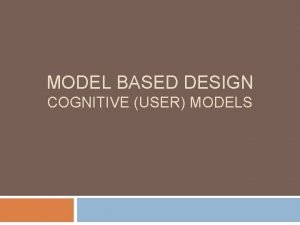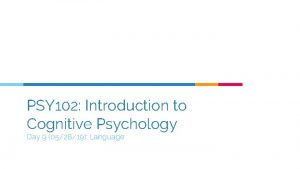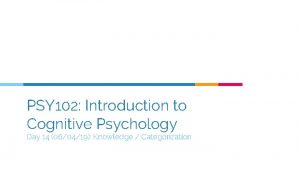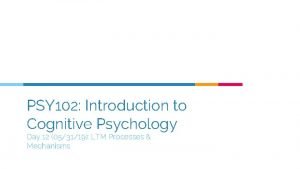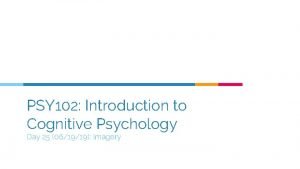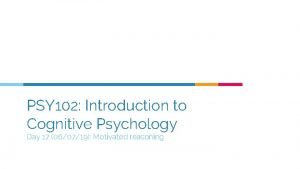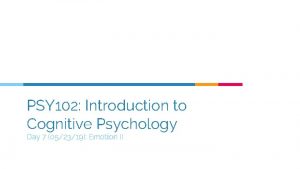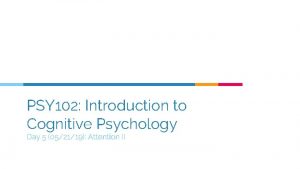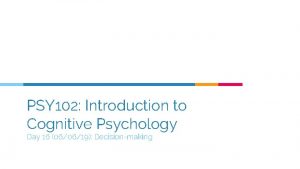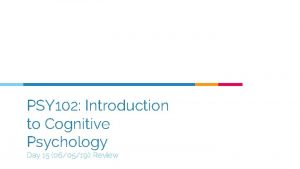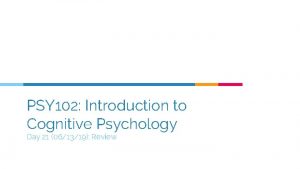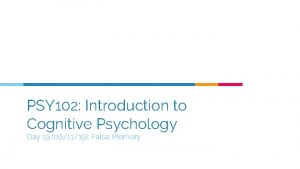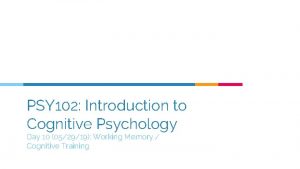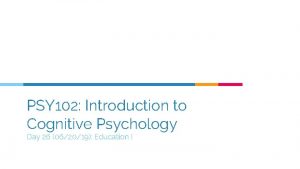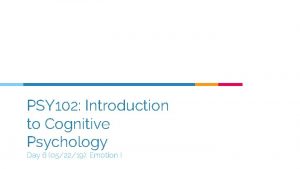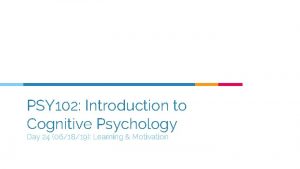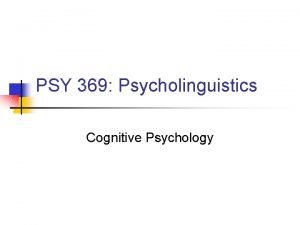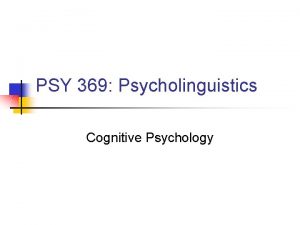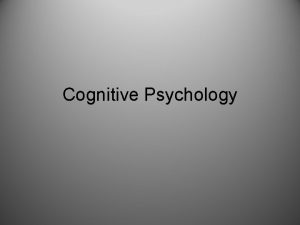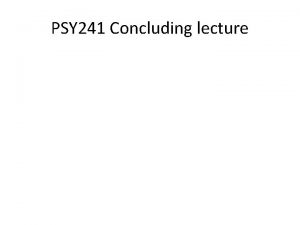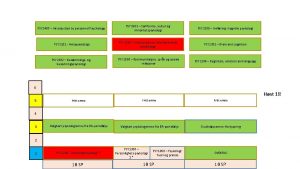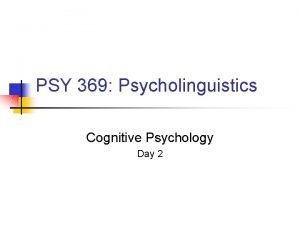PSY 102 Introduction to Cognitive Psychology Day 8









































































- Slides: 73

PSY 102: Introduction to Cognitive Psychology Day 8 (05/24/19): Review

Today’s Goals + Agenda 1. LO 1: Continue to build a supportive classroom culture & discuss science communication. ○ Peer feedback of opening Sci. Comm paragraphs in groups ○ Discuss choosing Wikipedia scientists for assignment 2. LO 2: Describe the basic history of cognitive psychology & cognitive psychology perspectives on cognitive neuroscience ○ Review material from discussing Day 2 methodology, plus some basic principles on cog neuro (i. e. , chpts 1 -2 reading) 3. LO 3: Review material that we have covered so far ○ Class feedback: wanted to slow down a bit & review Perception, some Attention concepts

What do you want to review? “All of Perception, exogenous and endogenous cueing, and dichotic listening task” “End of perception and beginning of attention” “top-down vs. bottom-up processing, endogenous/exogenous cueing, Bayesian priors/likelihood” “Top down vs bottom up, perception in general” “Late perception early attention” “Selective attention” “top-down vs. bottom-up processing, endogenous/exogenous cueing”

What do you want to review? 1. Perception (Bayesian priors/likelihood) 2. Top-down vs. bottom-up 3. Endogenous vs. exogenous Other: 1. Dichotic listening task 2. Early vs. late selective attention? (“late perception early attn”) 3. Model of Emotion Regulation (from yesterday’s minute paper) Which emotion theory is most popular today ?

Peer Feedback & Discuss Wikipedia Assignment Continue to build a supportive classroom culture & discuss science communication.

Peer feedback: Opening Paragraphs ▷ Get into groups of 2 -3 ▷ Exchange opening paragraphs ▷ Take the first couple of minutes to read the paragraph and write your thoughts on the paper ▷ Then, when you’re all/both finished, verbally discuss your feedback

Choose 4 Cog Psychologists https: //cogpsychduke 2019. github. io/wikipedia/ In case we have any overlap (i. e. , choosing the same person), please rank order your choices.

Textbook Readings Describe the basic history of cognitive psychology & cognitive psychology perspectives on cognitive neuroscience

Terms & People I Think Are Background Knowledge or Review Behaviorism Conditioning (classical, operant) Skinner, Watson Neurons (axon, dendrite, action potential, neuron doctrine) ▷ Cognitive methodology (f. MRI, DTI) ▷ ▷


Feature Detectors: neurons that respond best to a specific stimulus

Hierarchical Processing ▷ When we perceive different objects, we do so in a specific order that moves from lower to higher areas of the brain ▷ The ascension from lower to higher areas of the brain corresponds to perceiving objects that move from lower (simple) to higher levels of complexity

Specificity coding representation of a specific stimulus by firing of specifically tuned neurons specialized to just respond to a specific stimulus

Population Coding representation of a particular object by the pattern of firing of a large number of neurons

Sparse Coding when a particular object is represented by a pattern of firing of only a small group of neurons, with the majority of neurons remaining silent

Localization of Function ▷ Specific functions are served by specific areas of the brain ▷ Breaks down when area damaged ○ Double Dissociations ▷ Examples: ○ Language production: Broca’s area ○ Language comprehension: Wernicke’s area

How is information processed? Localized Representation ▷ ▷ ▷ Fusiform Face Area: faces ○ prosopagnosia Parahippocampal place area: places (indoor/outdoor scenes) Extrastriate body area: pictures of bodies & parts of bodies Distributed Representation ▷ ▷ ▷ In addition to localization of function, specific functions are processed by many different areas of the brain Many different areas may contribute to a function May appear to contradict the notion of localization of function, but the two concepts are actually complementary ○ E. g. , Kragel & Emotions

Takeaways ▷ ▷ Our minds aren’t perfect computers – they’re made up of shortcuts that were good enough when it came to solving the problems of the environment we evolved in These mechanisms can be fooled, which gives us clues as to how they work ▷ Cognitive psychologists can’t observe cognitive mechanisms directly – have to infer them by looking at behavior and physiology ▷ Organisms don’t have any direct access to reality – all we work with are neural representations Certain cognitive functions are localized to certain regions of the brain. Nevertheless, many neural representations involve a distributed pattern of activity in multiple brain areas at once. ▷

Optional: Test yourself ▷ Which of the following can a neuron use to code for information? ○ The size of action potentials ○ The shape of action potentials ○ The duration of action potentials ○ The frequency of action potentials ▷ What do cognitive psychologists talk about that behaviorists don’t? ▷ What are three different ways that neurons can represent a particular object? What are the two competing models for how neurons represent information at a higher level? ▷ Test yourself sections in the textbook too for Chpts 1 -2

Perception, Top. Down/Bottom-Up, Endogenous/Exogenous Review material that we have covered so far

Perception Review

Perception Is Ambiguous https: //www. nytimes. com/interactive/2018/05/1 6/upshot/audio-clip-yanny-laurel-debate. html

Perception Is Ambiguous

Challenges We, But Not Machines, Can Solve -- Why? ▷ Objects can be hidden or blurred ○ People can often identify objects that are obscured and therefore incomplete, or in some cases objects that are blurry ▷ Objects look different from different viewpoints ○ Viewpoint invariance ▷ Inverse Projection Problem ○ Refers to the task of determining the object responsible for a particular image on the retina ○ Involves starting with the retinal image and then extending outward to the source of that image

The Inverse Projection Problem

Top-down vs. Bottom-up: usually refers to start of stimulus processing ▷ Perception starts at the sensory input, the stimulus Top-down: processing originating in the brain, possibly other signals modulating bottom-up ▷ ▷ ▷ Perception could start with the brain Usually higher order cognitive processes Internal goals, prior knowledge, etc. influencing information processing ○ Pain, language, picture blobs (what do you see? ), etc. ○ Flower looks beautiful vs. specifically looking for a flower

4 Perspectives on Perception ▷ Helmholtz: retinal image ambiguous, so it solves ambiguity with the likelihood principle ○ We perceive the object most likely to have caused the pattern of stimuli we received ■ A Top-down approach on perception ○ Unconscious inference : our perceptions are also often the result of unconscious assumptions or inferences we make about the environment I. e. , Expectation and experience play a large role in perception, and sometimes we’re not even aware of that (“Learned Group”)



4 Perspectives on Perception ▷ Statistical regularities in the environment ○ The oblique effect ○ Light-from-above ○ Semantic regularities I. e. , Expectation and experience play a large role in perception, and sometimes we’re not even aware of that (“Learned Group”)

The Oblique Effect People can perceive verticals and horizontals more easily than other orientations Verticals and horizontals are more common in our world (“statistical regularity”) ▷ ▷ Trees, buildings, etc. (So neurons are also more tuned to verticals and horizontals too)

Light from Above ▷ ▷ ▷ Light comes from above Is usually the case in the environment We perceive shadows as specific information about depth and distance

Light from Above ▷ ▷ ▷ Light comes from above Is usually the case in the environment We perceive shadows as specific information about depth and distance

Semantic Regularities Close your eyes and then visualize or simply think about the following scenes and objects: a. An office b. The clothing section of a dept store c. A microscope d. A lion

Semantic Regularities Scene schemas : knowledge (from past experience) of what a given scene ordinarily contains ▷ An office: a desk, chair, etc.

4 Perspectives on Perception ▷ Bayesian Inference ○ Prior: our initial belief about the probability of an outcome ○ Likelihood: the extent to which evidence is consistent w/ an outcome ○ Estimate of outcome influenced by these 2 factors. We update our expectations based on incoming evidence, and this process happens repeatedly. I. e. , Expectation and experience play a large role in perception, and sometimes we’re not even aware of that (“Learned Group”)

4 Perspectives on Perception ▷ Gestalt psychologists: the mind groups patterns according to laws of perceptual organization: ○ Good continuation ○ Simplicity/Good Figure/Pragnanz ○ Similarity I. e. , a person’s experience can influence perception, but experience plays a smaller role than perceptual principles (i. e. , perception is intrinsic & has laws; “Innate Group”)

Good Continuation Lines tend to be seen as following the smoothest path

Simplicity: Five Circles, Not 9 Shapes Every stimulus pattern is seen so the resulting structure is as simple as possible

Similarity: Similar things appear grouped together “Waves” - Wilma Hurskainen

Experience-Dependent Plasticity The structure of the brain is changed by experience: the case of Greebles (Isabel Gauthier)

Processing Streams • What stream: identifying an object Where / Action pathway • Where stream: identifying the object’s location What / Perception pathway

Takeaways ▷ ▷ Our perceptions come about as a result of both top-down and bottom-up processing We automatically make inferences about raw sensory information to make meaning out of it Most psychologists emphasize the role of experience in the perceptual inferences we make. However, the Gestalt psychologists believed that perceptual inferences are intrinsic to the system (we don’t need to learn them) The Gestalt psychologists came up with a list of principles that they believed perception adheres to

Top-down/endogenous vs. Bottom-up/exogenous Review

Endogenous Cueing (Posner)

Exogenous Cueing

Contingent Capture: Top-down & bottom-up can interact Search for red equals sign (top-down goal); Only the red circles outside the box will capture attn (bottom-up) b/c of your top-down goal (where is the red =)? Trial starts here Folk et al. , 1992, JEP: HPP

Other Review

Early Selection: Broadbent’s Filter Model of Attention (1958): Filters message before incoming information is analyzed for meaning

“Intermediate” Selection: Treisman’s attenuation model of attention (1964): Attended message can be separated from unattended message early in the information-processing system; selection can still occur later

Late Selection Models Most information processed to level of meaning before message is selected ▷ People used dichotic listening tasks to differentiate the models, but no one answer to early vs. late debate

Gross’s model of emotion regulation

Today’s Goals + Agenda 1. LO 1: Continue to build a supportive classroom culture & discuss science communication. ○ Peer feedback of opening Sci. Comm paragraphs in groups ○ Discuss choosing Wikipedia scientists for assignment 2. LO 2: Describe the basic history of cognitive psychology & cognitive psychology perspectives on cognitive neuroscience ○ Review material from discussing Day 2 methodology, plus some basic principles on cog neuro 3. LO 3: Review material that we have covered so far ○ Class feedback: wanted to slow down a bit & review Perception, some Attention concepts

Tuesday’s Work ▷ Second Quiz ○ Attention, Emotion, Perception, Sensory Coding, Sci. Comm ▷ Choose 4 Cog Psychologists for Wikipedia ▷ Readings: ○ Bergelson & Aislin (2017) (Duke) ○ Yu et al. (2019) ○ Science News papers: Gutman (2017) (covering Bergelson paper) & Hayakawa and Marian (2019) (summary of language research in Sci. Am)

Participation https: //tinyurl. com/PSY 102 Participation

Practice Questions Optional: Test yourself on material

When Sam listens to his girlfriend Susan in the restaurant and ignores other people’s conversations, he’s engaged in the process of ___ attention. ▷ Low load ▷ Divided ▷ Cocktail party ▷ Selective

The cocktail party effect is ▷ The ability to pay attention to one stimulus while filtering out other stimuli ▷ The inability to pay attention to one stimulus in the presence of competing stimuli ▷ The diminished awareness of information in a crowd ▷ The equal division of attention between competing stimuli Follow-up: how does the cocktail party effect illustrate key characteristics of attention?

Broadbent’s model is called an early selection model because: ▷ The filter eliminates unattended information right at the beginning of the flow of information ▷ The filtering step occurs before the information enters the sensory store ▷ Only a select set of environmental information enters the system ▷ Incoming information is selected by the detector

Which of the following results would cause a problem for Broadbent’s early selection model: ▷ A result where listeners don’t notice words presented up to 35 times in the unattended ear ▷ A result where listeners can shadow a message presented in the attended ear ▷ A result where listeners can hear their own name in the unattended ear ▷ A result where listeners can shadow meaningful messages that switch from one ear to another 2 answers here

Suppose twin teenagers are vying for their mother’s attention. The mother is trying to pay attention to one of her daughters, though both girls are talking (one about her boyfriend, one about a school project). According to the operating characteristics of Treisman’s attenuator, it is most likely the attenuator is analyzing the incoming messages in terms of: ▷ Physical characteristics ▷ Language ▷ Meaning ▷ Direction

According to Treisman’s “attenuation model, ” which of the following would you expect to have the highest threshold for most people? ▷ The word ‘money’ ▷ Their child’s first name ▷ The word ‘home’ ▷ The word ‘platypus’

Suppose you are in your kitchen writing a grocery list, while your roommate is watching TV in the next room. A commercial for spaghetti sauce comes on TV. Although you are not paying attention to the TV, you ‘suddenly’ remember that you need to pick up spaghetti sauce and add it to the list. Your behavior is best predicted by which of the following models of attention? ▷ Object-based ▷ Early selection ▷ Spotlight ▷ Late selection

The Stroop effect occurs when participants ▷ Are told to divide their attention between colors and color-words ▷ Try to name colors and ignore the meaning of colorwords ▷ Try to select some incoming information based on meaning. ▷ Are told to shadow two messages simultaneously

What’s the difference between change blindness and inattentional blindness? Discuss 2 ways of demonstrating change blindness. Discuss how the process of binding is essential in your ability to watch a movie or television program. How does automaticity relate to multitasking? For Emotion, think about basics: how is an emotion generated? What do different theories tell us about how emotion is felt in the moment? What was the purpose of the papers you read? What is an emotion? How do we regulate our emotions?

MC answer key Slide 57: selective Slide 58: ability to pay attn Slide 59: filter eliminates Slide 60: bottom 2 arrow points Slide 61: meaning Slide 62: platypus Slide 63: late selection Slide 64: try to name colors

Test your perception knowledge

Computer programs have been designed that can recognize matching human faces with the same accuracy as a human being, but the computer loses its efficiency at this process when ▷ Animals faces are substituted for human faces ▷ The faces are of children ▷ The faces are viewed from an angle ▷ The faces are of people with scars or deformities

During a professional baseball game, a long fly ball is hit down the first base line toward the foul ball pole. If it goes to the right of the pole, it will be a foul ball, and if it goes to the left, it will be a home run. The umpire making this call will have the most difficulty making the judgment because: ▷ ▷ The umpire will be looking right at the foul pole instead of viewing it from an angle The human visual perceptual system is simply inefficient at making judgments in cases where the visual stimuli are more than a few feet away. It can be very difficult to distinguish one item from another when there is overlap between the two The ball will probably disappear from view whether it goes in front of or behind the foul pole

If a word is identified more easily when it is in a sentence than when it is presented alone, this would be an example of ____ processing. ▷ Top-down ▷ Bottom-up ▷ Serial ▷ Sequential

Maria took a drink from a container marked ‘milk. ’ Surprised, she quickly spit out the liquid because it turned out the container was filled with orange juice instead. Maria likes orange juice, so why did she have such a negative reaction to it. Her response was most affected by: ▷ Reception of the stimulus ▷ Bottom-up processing ▷ Top-down processing ▷ Focused attention

The results of Gauthier’s “Greeble” experiment illustrate: ▷ That neurons specialized to respond to faces are present in our brains when we are born ▷ That training a monkey to recognize the difference between common objects can influence how the monkey’s neurons fire to these objects ▷ An effect of experience-dependent plasticity ▷ That our nervous systems remain fairly stable in different environments

MC Answer Key Slide 68: viewed angle Slide 69: overlap Slide 70: top-down Slide 71: top-down Slide 72: experience dependent plasticity
 Day 1 day 2 day 3 day 4
Day 1 day 2 day 3 day 4 Day 1 day 2 day 817
Day 1 day 2 day 817 Cognitive and non cognitive religious language
Cognitive and non cognitive religious language Psychology 102 practice test
Psychology 102 practice test Euro psy
Euro psy Clep ucf
Clep ucf Psy2055
Psy2055 Psy 2055
Psy 2055 Xxxxblue
Xxxxblue Psy
Psy Psy sanin
Psy sanin Psy
Psy Psy
Psy Psy
Psy Psy
Psy Psy 226
Psy 226 Suppose twin teenagers are vying
Suppose twin teenagers are vying Psy academy
Psy academy Psy ku
Psy ku Psy walsh
Psy walsh Pes charakteristika
Pes charakteristika Dvercia rod
Dvercia rod 11 psy
11 psy Regression psy
Regression psy Psy
Psy Psy 335 purdue
Psy 335 purdue Csc 102 introduction to problem solving
Csc 102 introduction to problem solving Cognitive psychology concepts
Cognitive psychology concepts Balaji psychology
Balaji psychology History of cognitive psychology
History of cognitive psychology Cognitive appraisal psychology definition
Cognitive appraisal psychology definition Cognitive perspective strengths and weaknesses
Cognitive perspective strengths and weaknesses Cognitive psychology concepts
Cognitive psychology concepts Cognitive economy psychology definition
Cognitive economy psychology definition Sailboat metaphor positive psychology
Sailboat metaphor positive psychology History of cognitive psychology
History of cognitive psychology History of cognitive psychology
History of cognitive psychology Attention psychology definition
Attention psychology definition Outline and evaluate the cognitive approach
Outline and evaluate the cognitive approach Cognitive psychology crash course
Cognitive psychology crash course Cognitive model psychology
Cognitive model psychology Generative linguistics and cognitive psychology
Generative linguistics and cognitive psychology Introduction to psychotherapy ppt
Introduction to psychotherapy ppt Flashbulb memory ib psychology
Flashbulb memory ib psychology Cognitive levels of development
Cognitive levels of development Cognitive dissonance
Cognitive dissonance Transference ap psychology
Transference ap psychology Cognitive psychology
Cognitive psychology Transduction psychology
Transduction psychology Bottom up processing example
Bottom up processing example Cognitive psychology branches
Cognitive psychology branches Cognitive modelling
Cognitive modelling Artificial language
Artificial language Family portal schoolmax
Family portal schoolmax Oceans apart day after day meaning
Oceans apart day after day meaning Day to day maintenance
Day to day maintenance Physical science chapter 6 review answers
Physical science chapter 6 review answers Tomorrow i dont know
Tomorrow i dont know Act 2 romeo and juliet timeline
Act 2 romeo and juliet timeline Growing day by day
Growing day by day Define seed dormancy
Define seed dormancy Seed germination conclusion
Seed germination conclusion Role of transpiration
Role of transpiration I live for jesus day after day
I live for jesus day after day Rising he justified freely forever
Rising he justified freely forever Day one day one noodle ss2
Day one day one noodle ss2 Afc futsal coaching course level 1
Afc futsal coaching course level 1 Positive psychology ap psychology definition
Positive psychology ap psychology definition Social psychology definition
Social psychology definition Fundamental attribution error ap psychology
Fundamental attribution error ap psychology Introspection method in psychology
Introspection method in psychology Social psychology definition psychology
Social psychology definition psychology Health psychology definition ap psychology
Health psychology definition ap psychology 4 forces of nature
4 forces of nature



